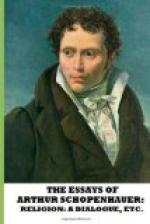The fundamental characteristics of the Jewish religion are realism and optimism, views of the world which are closely allied; they form, in fact, the conditions of theism. For theism looks upon the material world as absolutely real, and regards life as a pleasant gift bestowed upon us. On the other hand, the fundamental characteristics of the Brahman and Buddhist religions are idealism and pessimism, which look upon the existence of the world as in the nature of a dream, and life as the result of our sins. In the doctrines of the Zendavesta, from which, as is well known, Judaism sprang, the pessimistic element is represented by Ahriman. In Judaism, Ahriman has as Satan only a subordinate position; but, like Ahriman, he is the lord of snakes, scorpions, and vermin. But the Jewish system forthwith employs Satan to correct its fundamental error of optimism, and in the Fall introduces the element of pessimism, a doctrine demanded by the most obvious facts of the world. There is no truer idea in Judaism than this, although it transfers to the course of existence what must be represented as its foundation and antecedent.
The New Testament, on the other hand, must be in some way traceable to an Indian source: its ethical system, its ascetic view of morality, its pessimism, and its Avatar, are all thoroughly Indian. It is its morality which places it in a position of such emphatic and essential antagonism to the Old Testament, so that the story of the Fall is the only possible point of connection between the two. For when the Indian doctrine was imported into the land of promise, two very different things had to be combined: on the one hand the consciousness of the corruption and misery of the world, its need of deliverance and salvation through an Avatar, together with a morality based on self-denial and repentance; on the other hand the Jewish doctrine of Monotheism, with its corollary that “all things are very good” [Greek: panta kala lian]. And the task succeeded as far as it could, as far, that is, as it was possible to combine two such heterogeneous and antagonistic creeds.
As ivy clings for the support and stay it wants to a rough-hewn post, everywhere conforming to its irregularities and showing their outline, but at the same time covering them with life and grace, and changing the former aspect into one that is pleasing to the eye; so the Christian faith, sprung from the wisdom of India, overspreads the old trunk of rude Judaism, a tree of alien growth; the original form must in part remain, but it suffers a complete change and becomes full of life and truth, so that it appears to be the same tree, but is really another.




